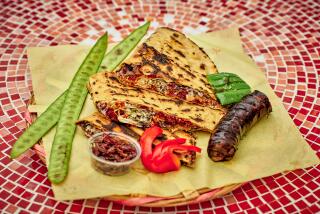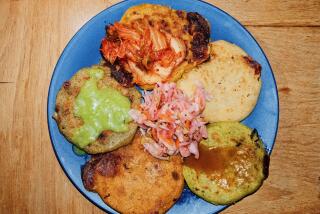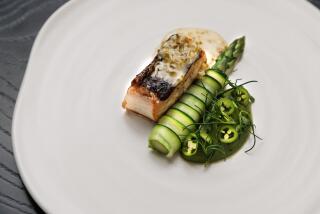A culinary walk through Barcelona
The best way to get to know the culture of any place is to eat your way through it. This is especially true in Barcelona, the epicenter of Catalonia. Perhaps it’s because Catalan food is such a good reflection of the culture. Historically, Catalans have had their kitchens invaded by a diverse crowd, including the Visigoths and the French.
The result is a cuisine that’s both unpretentious and sophisticated, much like the Catalans themselves.
And when you consider that the Catalans have contributed pan con tomate (bread rubbed with tomato, garlic and olive oil) as well as Ferran Adrià’s high-tech foam concoctions to the culinary scene, you begin to get an idea just how diverse Catalan cuisine can be.
You also start to get some insight into the complexities of the Catalan character. Which means, if you’re looking to understand the soul of Catalonia, start with the food.
Shop for it
There are more than 40 markets in Barcelona, but the best known is La Boqueria, one of the largest food markets in Europe. More locals than tourists turn up here to buy slabs of stiff dried bacalao (cod), fresh anchovies and entire haunches of jamón íberico (locally raised ham). Stand in front of one of these ham stands and inhale deeply. Be sure to look for the black hoof. It means that the pig feasted only on acorns and is the sign of the highest quality ham.
Other things to look for are bull meat, frequently from the loser in a bullfight, and razor clams tucked into shells ornate enough to have been designed by Antoni Gaudí, Barcelona’s favorite son. Note that the most expensive stands tend to be in the middle. If you are looking for something specific among the 300 stands, pay a visit to the information center upstairs, where a quick check on the computer can tell you which stands have what you’re looking for, and at what price.
Other markets of note include the slightly smaller Mercat Santa Caterina, and the seafood-centric Mercat de Barceloneta, in the adjacent portside town of Barceloneta.
Cook it
Of course, doing La Boqueria on your own is one thing, doing it in the company of a local chef is something else entirely. And that something else entirely is the first half of a Cook & Taste cooking class. Begin at the market, where fishmongers will compete to sell you the inkiest cuttlefish and the bristliest prawns. Wander through the open-air courtyard where farmers will swear that their giant figs are the sweetest.
Once you’ve filled the shopping cart with clams and tomatoes, pasture-raised eggs and a thick packet of that incredible ham, wind your way through the narrow Gothic streets to the Cook & Taste kitchen, a rustic stone-walled and yellow-tiled room with a long demonstration counter. If you’re feeling very “Iron Chef,” grab a knife and start cutting the whiskers off prawns or whipping up a batch of sofrito, the chopped garlic and tomato mixture that is the base of much Spanish cooking. If you’re feeling more Paul Child than Julia, settle in at the counter and learn by observation. Either way, when the cooking is done, everyone takes a seat, raises a glass and digs in to a garlicky tomato soup served in shot glasses, an omelet stuffed with potatoes and onions, a saffron-scented seafood paella and a sinful crema catalana.
Eat it
Ever since chef Adrià started blasting meat with cans of nitrous oxide and transforming it into foam at El Bulli, Barcelona restaurants have come in two flavors: traditional and with-a-twist.
Chef Carles Gaig’s Fonda Gaig falls into the traditional camp. The atmosphere is comfortably modern, with cushioned leather armchairs pulled up to tables covered in brilliantly white linen. The menu is traditional enough to have been written by a true Catalan grandmother, including such classics as patates braves (fried potatoes in a spicy sauce) and bacalla a la llauna (pan-baked cod). But the execution takes tradition to a new level. At lunchtime at Fonda Gaig, a more affordable outpost of the more upscale Gaig Restaurant, the chef himself will generally pop out of the kitchen and take your order.
On the other hand, Canadian-Catalan chef Jordi Artal is in the with-a-twist camp, putting a modern spin on traditional Catalan cuisine at his Cinc Sentits, which translates as “five senses.” In Artal’s hands, traditional pan con tomate is reinvented as garlic air and tomato purée served with small squares of rustic bread on a giant white plate with a small well in the center filled with a delicious olive oil.
The dishes on the sensacions tasting menu are meant to stimulate each of the five taste sensations (sweetness, bitterness, sourness, saltiness and umami), and Artal accomplishes this using mostly local ingredients such as wild Mediterranean red mullet, Iberian suckling pig and beef from the Pyrenees. Cinc Sentits was recently awarded a well-deserved Michelin star.
The Roca brothers, who run a restaurant in nearby Girona, are nearly as famous as the nitrous-wielding Adrià, and now it’s no longer necessary to hop a train to eat in one of their restaurants. Moo, in the ultra-hip Hotel Omm, is definitely Catalan cuisine in the future tense. In fact, it’s a kind of meta-food, in which nothing looks the way you’d expect.
The foie gras arrives in a neon green caramelized apple. Those things that look like bird’s nests on your plate are actually deliciously crispy pieces of shaved prawn. Your cheese course might arrive in a tiny Mason jar. The food is inventive and immensely satisfying.
Technically, tapas aren’t Catalonian, but Barcelona has embraced the tapas restaurant, so no reason you shouldn’t as well. For a modern take on tapas, visit Cuines Santa Caterina, adjacent to the Mercat de Santa Caterina. Check out the back wall, where fresh herbs grow vertically to the ceiling. Then grab a table or sit at the bar and order from the extensive tapas menu. Cuines Santa Caterina features tapas classics such as thinly sliced fried artichokes and little potato omelets, as well as more modern inventions such as mini-hamburgers, topped with Brie, and Thai chicken curry. At the juice bar they’ll squeeze you a lemon, ginger and mint drink.
For a traditional take on tapas, head over to La Cova Fumada, in the seaside town of Barceloneta. The wine is siphoned out of a barrel, which may explain why everybody is drinking beer, and you’ll probably have to share a table. But the spicy potato bomba is delicious, as are the sardines and everything else on the menu.
Walk it off
By this point, you might be ready for a little exercise. Barcelona Turisme has a map for a self-guided Gourmet Walking Tour around the Gothic Quarter. Or you can hire a guide to give you a more in-depth look at much of the same route, which begins near La Boqueria and ends near Mercat Santa Caterina.
Here are some highlights. Granja Viader has been serving incredible milk-based drinks since 1870. If it’s cold, try a hot chocolate. If it’s hot, sample a cacaolat. All the dairy products here come from local farms. If you’ve always wanted your photograph done in chocolate, you can have it at Pastissería Escribà.
On nearby Carrer de Petritxol you’ll find several cafes called granjas (or granges), which means they specialize in dairy products and cakes. Stop in at granjas Dulcinea or Pallaresa to sample Catalan-style pastries.
If all these sweets have made you crave something more savory, visit La Pineda, where you’ll find locally made sausages, cheeses and an assortment of vinegars. You know you want the opportunity to tell your friends that you sampled the “nun’s farts,” so better head to Caelum, the sweet shop where all the goodies are made by Spanish nuns and monks. (You’ll be relieved to know that the aforementioned are chocolate cookies.)
Taste it
From wine to ham to tapas, Barcelona offers plenty of tasting tours. One of the best is Taste of Spain’s Olive Oil Tasting, which is held at d’Olis d’Oliva’s sparkling glass-walled shop at the Mercat Santa Caterina. Spain is home to 262 varieties of olives, and when you consider that oil can be made from either a single olive or a blend, that’s a lot of olive oil.
The Taste of Spain tasting guide however, recommends sampling no more than about five at one sitting. After that, they start to taste much the same. You sample olive oil much the way you would sample a fine whiskey, in a shot glass. Straight up, olive oil can taste buttery, or grassy, or even leave a scratchy feeling at the back of your throat, a sensation caused by the anti-inflammatory properties of olive oil. The good news: Most of the oil is reasonably priced and d’Olis d’Oliva ships all over the world.
More to Read
Sign up for The Wild
We’ll help you find the best places to hike, bike and run, as well as the perfect silent spots for meditation and yoga.
You may occasionally receive promotional content from the Los Angeles Times.






